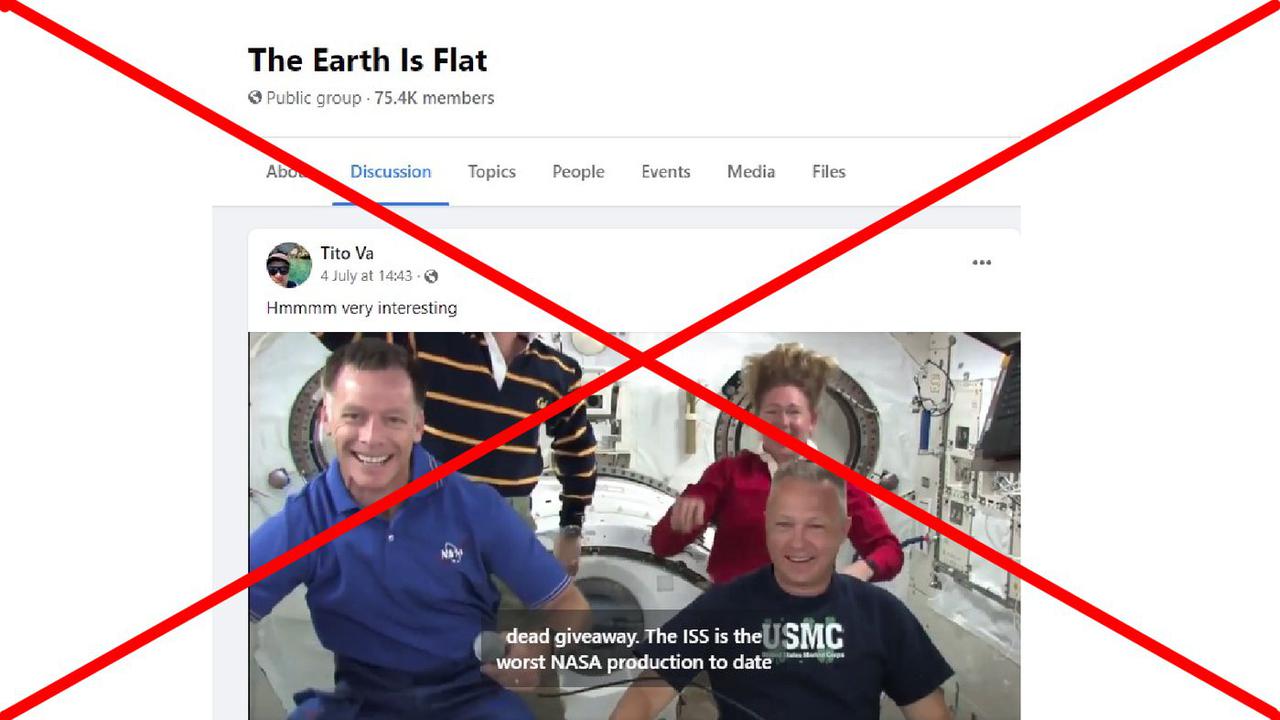WHAT WAS CLAIMED
Footage of an astronaut's hair standing up without moving proves the International Space Station is a hoax.
OUR VERDICT
False. The astronaut's hair naturally stands on end in zero gravity and its movement depends of the length and thickness.
A video posted on Facebook by a New Zealand user claims to show proof the International Space Station (ISS) is a hoax.
The video (screenshot here), shared on flat earth group on July 4, purports footage of an ISS astronaut's hair standing on end without moving proves it was shot in a studio. It claims hair does not behave that way in zero gravity and long hair would not be allowed on a spaceship as it clogs air filters.
However, experts have given the claim a buzz cut, telling AAP FactCheck the footage shows exactly how you would expect the astronaut's hair to act in zero gravity. They also say the space station's air filters have no problem dealing with human hair shed by its inhabitants.
The video claims female ISS crew members use hairspray to keep their hair standing up while being filmed. The narrator contrasts this with footage of a woman in a zero-G parabolic aeroplane flight whose long locks flow about her as if she's in a swimming pool (video mark 1min 25sec).
Swinburne University astrophysicist Sara Webb says how hair behaves in zero gravity depends on its length and strength.
"Hair long enough (and thin enough) does move around with change in inertia.Those astronauts used as examples all have short/curly hair," Dr Webb told AAP FactCheck in an email.
She said a video from July 2013 of NASA astronaut Karen Nyberg washing her longer, thinner hair in the ISS shows how it flows with movement in space. Another example can be seen here in a 2021 interview with astronaut Megan McArthur on the ISS.
Astronomer Fred Watson agrees the astronaut's hair in the Facebook video acts exactly how you would expect in space. He pointed to another video of Karen Nyberg which demonstrates the physics for longer, thinner hair.
"Weightlessness means everything floats around. I think if your hair is particularly wafty like Karen's you'd take it into a pony-tail … Otherwise its natural stiffness will tend to keep it in place - as in the offending video," Professor Watson told AAP FactCheck in an email.

Dr Webb also says parabolic flight does not offer a true reflection of zero gravity in space.
"The video of the 'zero G' from the parabolic flight is also problematic, with these flights having apparent zero G for only very short timescales with the gravity vectors having dramatic effects on movement when they come out of the climb (they fall to the ground and the gravity on their body is multiple g)."
As for the claim long hair clogs up filters on the ISS, Dr Webb says the space station's filtration system has no problem dealing with hair, as well as the 500 million skin cells humans shed each day.
"Unlike on earth, 'dust' can't form and settle because of gravity," she said. "So the ISS has a complex filtration system to deal with all of this and needs to be managed and cleaned over time (just like your home's air-con has a filter, which also needs changing/cleaning)."
Studies have shown HEPA filters in the ISS do a surprisingly effective job of keeping the air clean, considering astronauts remain in its sealed environment for months.
Footage from the space station can be seen on NASA's live webcam and the ISS's YouTube channel, with images of the planet posing more curly questions for flat earthers.
The Verdict
A Facebook video's claim the International Space Station is a hoax because footage shows a female astronauts' hair standing up without moving is false. Experts say whether hair in space stands on end or wafts around with movement depends on its length and thickness. They also told AAP FactCheck long hair poses no threat to the ISS's air filters.
False – The claim is inaccurate.
AAP FactCheck is an accredited member of the International Fact-Checking Network. To keep up with our latest fact checks, follow us on Facebook, Twitter and Instagram.












